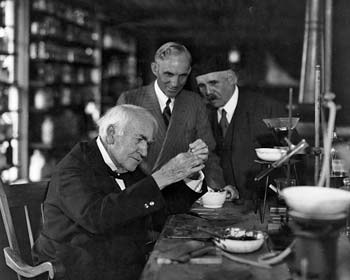During the strain of searching for the right burner or filament for the electric lamp, he never showed impatience.
在為電燈尋找合適燈絲的壓力中,他從未表現出急躁。
The first lamp that he made had a cotton thread for a filament, and it could burn for only forty-five hours.
他制造的第一盞燈中是一根細絲狀的棉線,只能燃燒四十五小時。
A filament had to be discovered that would be still glowing at the end of six hundred hours.
他必須發現一種燈絲,在使用六百小時后仍可以發光。
The search began, and it led to all parts of the earth.
搜尋開始了,并延伸到了地球的各個角落。
Men went to the jungles of Ceylon, to India, and throughout the valley of the Amazon River in search of different kinds of bamboo.
人們前往錫蘭的叢林、印度以及整個亞馬遜河山谷,尋找各種竹子。
Over six thousand kinds of material were tested in thirteen months. One hundred thousand dollars were spent.
在13個月中測試了六千多種材料,花費了十萬美元。
Hope, despair, and disappointment followed one upon another, until finally one kind of bamboo was found that would burn for a long, long time.
希望、絕望和失望接踵而至,直到最后發現一種可以亮很長時間的竹子。

1879年12月31日的一份芝加哥舊報紙刊登了下面兩份電報,
which tell the story of the interest the world took in the experiments Edison was making for a filament that would last:
講述了全世界對愛迪生尋找持久燈絲所做實驗感興趣的故事:
December 30, 11 a. m., 1879 To Prof. Thomas A. Edison Menlo Park, N. J.
1879年12月30日上午11點,致愛迪生教授,新澤西門洛帕克。
How long have your first lighted carbon horse-shoe electric lamps given continuous light? Editor, Tribune
您最先點亮的碳化馬蹄電燈亮了多長時間?論壇報編輯。
Dec. 30, 4 p. m., 1879 To Editor Chicago Tribune Chicago, 111.One week today and still burning. Edison
1879年12月30日下午4點,致《芝加哥論壇報》的編輯,到今天已經亮了一周,而且仍然亮著。愛迪生。
There are 168 hours in a week; so men knew that the electric lamp had come to stay.
一周有168個小時,所以人們知道,電燈已經可以持續亮著了。
No matter what the cost was, a lamp that would burn this long was worth producing.無論成本是多少,一盞可以亮這么長時間的燈都值得生產。











